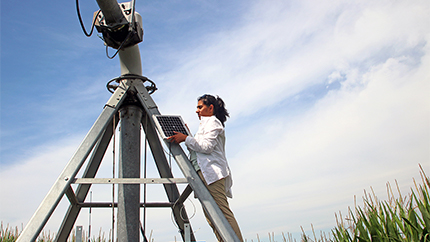DWFI and The Climate Corporation recently completed their second year of an irrigation scheduling project that started in spring 2018. The project’s goal to better understand the field level application of evapotranspiration (ET) research. Understanding plant ET can help farmers know how much and when to irrigate, to make best use of our water resources.
Despite a rainy spring year, we provided irrigation recommendations for 11 center pivot irrigated corn fields on a weekly basis, maintaining communication directly with the growers. Each field was divided into three sections, with irrigation prescriptions divided three ways:
- ½ based on regular grower management
- ¼ determined by The Climate Corporation's proprietary software
- ¼ by DWFI researchers using weather data, satellite thermal imagery, past irrigation data, soil mapping, soil water monitoring and SETMI (Spatial Evapotranspiration Modeling Interface)
While we have yet to receive all yield data from growers, a quick summary of irrigation amounts shows that we have very high variation between the fields. The smallest total application was 2.8 inches for a field while the largest was 11.3 inches for another field. This variation is primarily due to field geographic locations and varying rainfall. Some hail events also forced us to drop two fields from the study.
During this project, we learned a lot about the farming trends, farmers’ irrigation decisions and field technology used by farmers. Some key lessons we’ve come away with are:
- It is important to learn about farm technology like pivot mechanics, well capacity, etc. Often we saw that after generating water demand using models, we were limited by how much water the pivot can actually apply within one week. For X amount of water, some pivots need 20 hours to finish a circle while some need up to 30 hours. Thus, it is very important to adjust modeled numbers for realistic field level implementation.
- Limitations to our recommendations included fertilizer applications, electricity costs and unprecedented rainfall. Farmers were always willing to comply, unless they were limited by one of the factors mentioned above. Fertilizer applications are generally flat rate. Power companies offer a large amount of electricity cost reduction if farmers allow maximum load control. When a grower wishes to allow load control, power companies can control their pivots and shut them off during whatever number of days per week the grower enrolled for. Growers do not change this schedule for any reason, since there is a great trust already built and there is an immediate economic benefit involved.
- Grower decision making on irrigation was the most important lesson involved in implementing an irrigation schedule. There is a multitude of factors involved in deciding when to run a pivot and how much water to apply. Is the pivot on load control for next two days? Will it rain or not? What if the heat index increases in the two days of load control? All growers were very informed on the soil structure and water holding capacity. However, most of their decisions are based on rainfall events and temperature. Two to three days a week, they were typically on load control. If rainfall is in forecast, they would wait it out. Athe same time, almost all growers use rain buckets to account for local precipitation events, which are missed by weather stations and models.
“All models are wrong, but some are useful.” This quote was first said by George E.P. Box, but I first heard it when a grower in the study quoted this to me. Since then, I have learned in real sense what he meant.
There were some late harvests as a result of flooding early in the spring and late plantings. We will now be collecting yield data from growers, and making biomass maps to estimate the results. These will be compared with irrigation data to further explore the three irrigation prescription methods and determine next steps for the project in the United States.
Irrigation scheduling project in India

Starting December 2019, I will be implementing a similar project in Delhi, India at Indian Agricultural Research Institute (IARI) research plots. The objective is to develop sensor-operated precision irrigation and fertigation systems that are both energy efficient and conserve water.
Unlike the project in the United States, the India project is a small holder farming model, where smaller plots are created for testing of field equipment designed for precision-irrigation. This is crucial in India considering the drier conditions and frequent droughts. The energy-efficiency component involves the potential to switch to solar irrigation pumps (which is very different than load control in Nebraska). The field equipment mostly involves portable sensors that can collect soil moisture and canopy temperature (as opposed to semi-permanently planting them in field in Nebraska) to avoid risks of theft and vandalism. Different irrigation depths will be tested keeping local factors and irrigation technology in mind.
Through both projects, I am continuously learning what works on the ground and how to make our theories more applicable in practice. As I continue my work, I hope to achieve the balance and make our science increasingly more useful to growers both in Nebraska and around the world.


